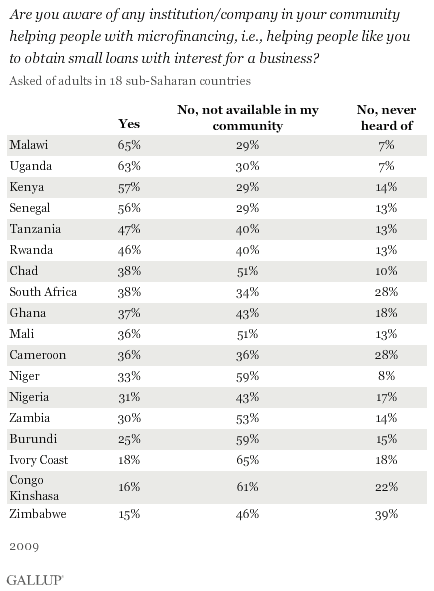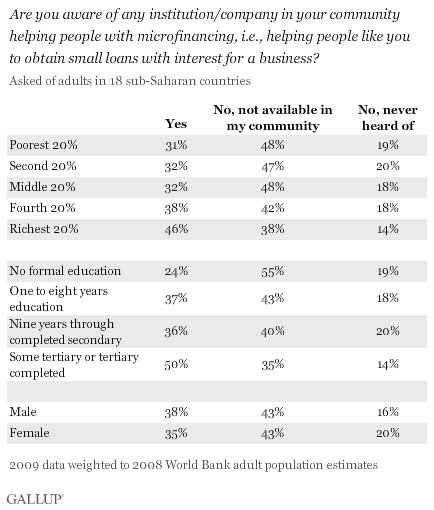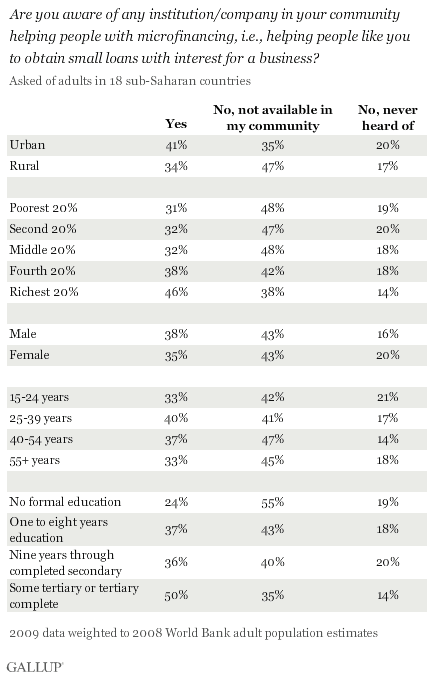WASHINGTON, D.C. -- Residents in sub-Saharan African countries report a wide range of awareness about the availability of microfinance lending in their communities, suggesting these institutions remain locally inaccessible to many who would benefit most from using them. Malawians (65%) and Ugandans (63%) are the most likely to say they are aware of these institutions in their communities, while respondents from Ivory Coast (18%), Democratic Republic of the Congo (16%), and Zimbabwe (15%) are the least likely to say the same.

On average, 36% of residents in the 18 countries Gallup surveyed are aware of these institutions or companies in their communities. In some countries, the recent introduction of microfinance institutions or rapid industry growth may be driving awareness. For example, in Malawi microfinance portfolios doubled in 2008 because of rapid growth among newer microfinance institutions.
More than 4 in 10 sub-Saharan Africans (43%) say they have heard of microfinance institutions but that they are not available in their communities. An additional 18% say they have never heard of microfinance institutions. Although respondents in Ivory Coast, DRC, and Zimbabwe are among the least likely to say they are aware of these institutions in their communities, many say they have heard of them but they aren't available in their communities. Pluralities in 10 countries surveyed share this sentiment, indicating widespread awareness of microfinance lending, but less widespread availability.
Microfinance is generally seen as a financial tool for microenterprises and individuals living below the poverty line. However, respondents from the poorest and least educated groups, arguably the most important groups to target, are most likely to say these services are not available in their communities. While women make up 57% of all microfinance borrowers in sub-Saharan Africa, according to a 2009 microfinance report by the Microfinance Information eXchange, men are slightly more likely to be aware of these institutions and less likely to say they have never heard of them.

Bottom Line
While there were 6.5 million microfinance borrowers in sub-Saharan Africa by the end of 2008, this number represents 3% of the potential market, indicating considerable room for growth. This is evident in the more than three in five sub-Saharan Africans who have never heard of microfinance institutions or say they are not available in their communities. Efforts will need to be made to reach groups that can benefit most from microloans, namely individuals living below the poverty line. Although microfinance has been praised as a powerful tool for reducing poverty, there is still a long way to go before this economic development tool is fully used in sub-Saharan Africa.
For complete data sets or custom research from the more than 150 countries Gallup continually surveys, please contact SocialandEconomicAnalysis@gallup.com or call 202.715.3030.
Survey Methods
Results are based on 18,000 face-to-face interviews with adults, aged 15 in older, conducted in 2009. A minimum of 1,000 interviews were conducted in each of the following countries: Burundi, Cameroon, Chad, Congo Kinshasa, Ghana, Ivory Coast, Kenya, Malawi, Mali, Niger, Nigeria, Rwanda, Senegal, South Africa, Tanzania, Uganda, Zambia, and Zimbabwe. For results based on the total sample of national adults, one can say with 95% confidence that the margin of error ranged from a low of ±3.5 percentage points in Ivory Coast and Niger to a high of ±4.8 percentage points in Senegal. For results based on demographic subgroups, one can say with 95% confidence that the margin of error is between ±1 and ±2 percentage points. The margin of error reflects the influence of data weighting. In addition to sampling error, question wording and practical difficulties in conducting surveys can introduce error or bias into the findings of public opinion polls.

